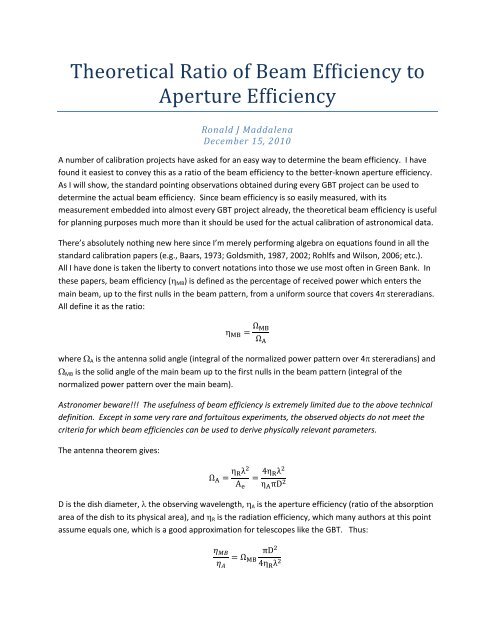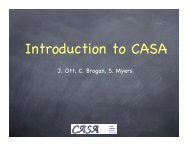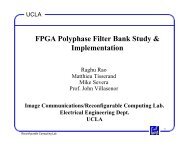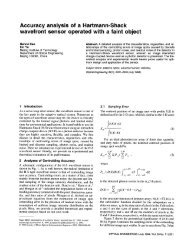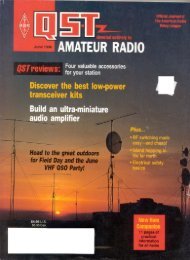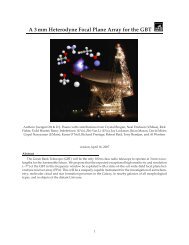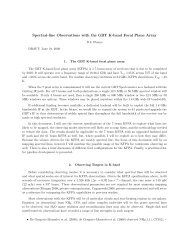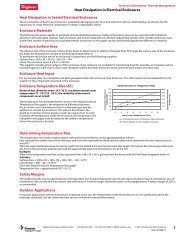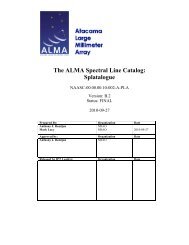Theoretical Ratio of Beam Efficiency to Aperture Efficiency
Theoretical Ratio of Beam Efficiency to Aperture Efficiency
Theoretical Ratio of Beam Efficiency to Aperture Efficiency
Create successful ePaper yourself
Turn your PDF publications into a flip-book with our unique Google optimized e-Paper software.
<strong>Theoretical</strong> <strong>Ratio</strong> <strong>of</strong> <strong>Beam</strong> <strong>Efficiency</strong> <strong>to</strong><br />
<strong>Aperture</strong> <strong>Efficiency</strong><br />
Ronald J Maddalena<br />
December 15, 2010<br />
A number <strong>of</strong> calibration projects have asked for an easy way <strong>to</strong> determine the beam efficiency. I have<br />
found it easiest <strong>to</strong> convey this as a ratio <strong>of</strong> the beam efficiency <strong>to</strong> the better-known aperture efficiency.<br />
As I will show, the standard pointing observations obtained during every GBT project can be used <strong>to</strong><br />
determine the actual beam efficiency. Since beam efficiency is so easily measured, with its<br />
measurement embedded in<strong>to</strong> almost every GBT project already, the theoretical beam efficiency is useful<br />
for planning purposes much more than it should be used for the actual calibration <strong>of</strong> astronomical data.<br />
There’s absolutely nothing new here since I’m merely performing algebra on equations found in all the<br />
standard calibration papers (e.g., Baars, 1973; Goldsmith, 1987, 2002; Rohlfs and Wilson, 2006; etc.).<br />
All I have done is taken the liberty <strong>to</strong> convert notations in<strong>to</strong> those we use most <strong>of</strong>ten in Green Bank. In<br />
these papers, beam efficiency (η MB ) is defined as the percentage <strong>of</strong> received power which enters the<br />
main beam, up <strong>to</strong> the first nulls in the beam pattern, from a uniform source that covers 4π stereradians.<br />
All define it as the ratio:<br />
η Ω <br />
Ω <br />
where Ω A is the antenna solid angle (integral <strong>of</strong> the normalized power pattern over 4π stereradians) and<br />
Ω MB is the solid angle <strong>of</strong> the main beam up <strong>to</strong> the first nulls in the beam pattern (integral <strong>of</strong> the<br />
normalized power pattern over the main beam).<br />
Astronomer beware!!! The usefulness <strong>of</strong> beam efficiency is extremely limited due <strong>to</strong> the above technical<br />
definition. Except in some very rare and fortui<strong>to</strong>us experiments, the observed objects do not meet the<br />
criteria for which beam efficiencies can be used <strong>to</strong> derive physically relevant parameters.<br />
The antenna theorem gives:<br />
Ω η λ <br />
A <br />
4η λ <br />
η πD <br />
D is the dish diameter, λ the observing wavelength, η A is the aperture efficiency (ratio <strong>of</strong> the absorption<br />
area <strong>of</strong> the dish <strong>to</strong> its physical area), and η R is the radiation efficiency, which many authors at this point<br />
assume equals one, which is a good approximation for telescopes like the GBT. Thus:<br />
<br />
<br />
Ω <br />
πD <br />
4η λ
One can derive this ratio from any <strong>of</strong> the GBT pointing measurements by determining the approximate<br />
angular <strong>of</strong>fset at which the measured beam pr<strong>of</strong>ile meets the baseline. If the beam can be assumed <strong>to</strong><br />
be symmetric, then just one <strong>of</strong> the two orthogonal directions in the pointing is needed. Otherwise, one<br />
can assume an elliptical beam and use the measured widths in the two orthogonal directions as the<br />
major and minor axes <strong>of</strong> an equivalent ellipse.<br />
Since it may be difficult <strong>to</strong> determine the angular distance at which the beam obtains its first null (e.g.,<br />
the source is weak or one is confusion limited), one can assume the beam is Gaussian and use the<br />
measured full-width, half maximum beam width (FWHM) as a proxy for the width at the first null.<br />
Various authors give the following approximation:<br />
Ω 1.13 · θ <br />
· θ <br />
<br />
Here, θ is the width in the two orthogonal directions <strong>of</strong> our pointings. In most cases, especially at low<br />
frequencies, these can be considered the same. Following on with the algebra:<br />
<br />
πD <br />
1.13 · θ<br />
· θ ·<br />
4η λ <br />
For the GBT, the standard published relationship is θ(radians) ≈ 1.23x10 -4 λ(cm), though one must realize<br />
that the multiplicative fac<strong>to</strong>r depends upon the details <strong>of</strong> the feed illuminations, which differs not only<br />
from receiver <strong>to</strong> receiver but also within each receiver’s band.<br />
Alternatively, if estimates or measurements <strong>of</strong> the beam width are unavailable, one can determine an<br />
approximate theoretical beam width from a known feed illumination taper using:<br />
1.02 0.0135 · <br />
(Goldsmith, 1987, 2002), which assumes a feed illumination with a Gaussian taper, as is the case for<br />
most GBT receivers. Thus,<br />
<br />
<br />
1.13 · 1.02 0.0135 · ·<br />
Due <strong>to</strong> the somewhat strong dependence on feed taper, the value <strong>of</strong> this ratio can vary substantially.<br />
<br />
<br />
.<br />
For example, since standard feed tapers for the GBT can vary from 12 <strong>to</strong> 17 dB, and assuming η R =1,<br />
η MB /η A can range from ≈1.16 <strong>to</strong> 1.39. Our ‘standard’ taper <strong>of</strong> 15 dB gives η MB /η A ≈ 1.32. For the 43-m<br />
when it was using hybrid feeds, the measured ratio was ≈1.38.<br />
References<br />
Baars, J.W.M, 1973, IEEE Trans on Ant and Prop, Vol AP-21, No. 4, p. 461.<br />
Goldsmith, P., 1987, Int Journal <strong>of</strong> Infrared and Millimeter Waves, Vol. 8, No. 7, p. 771.<br />
Goldsmith, P, 2002, in Single-Dish Radio Astronomy: techniques and Applications, ed. Stanimorivic,<br />
Altschuler, Goldsmith, and Salter (ASP, Vol. 278), p. 45.<br />
Rohlfs, K. and Wilson, T.L., 2006, Tools <strong>of</strong> Radio Astronomy (Berlin: Springer.


